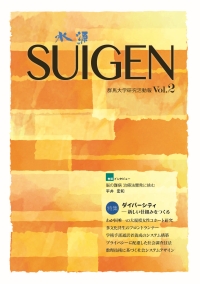

 Intractable Brain Disease: The Challenge of
Developing a Cure
Intractable Brain Disease: The Challenge of
Developing a Cure Professor Hirokazu Hirai is engaged in the
development of foundational technologies for the treatment of rare
brain-related diseases. He is currently involved in the "Project
for Comprehensive Understanding of Brain Function Networks through
Innovative Technologies" led by the Japan Agency for Medical
Research and Development. Professor Hirai is responsible for
"creating new technologies." One significant achievement of his
previous research is the highly efficient expression of foreign
genes in specific cell groups within the primate marmoset brain.
The next aim is to develop a "carrier" for genes that can
penetrate the barrier between the blood vessels and the brain
(blood-brain barrier). Once this technology is completed, it is
expected to accelerate significantly various basic and clinical
research worldwide.
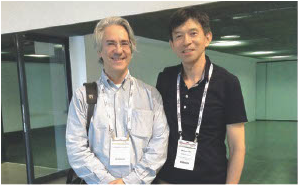
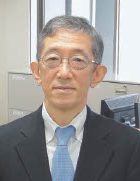
A field of study focuses on researching the
causes and prevention of diseases in populations. It is called
epidemiology. One of its methodologies, cohort studies, involves
collecting and analyzing data from a large group of subjects over
an extended period to investigate the relationship between factors
such as lifestyle, environment, and health. Professor Kunihiko
Hayashi has conducted a cohort study since 2001, targeting tens of
thousands of working women nationwide. This large-scale women's
cohort study is the first in Japan. Professor Hayashi is also the
only participant from Asia in an international research project
that integrates and analyzes women's cohort studies worldwide.
Epidemiology throughout a woman's life, from "fetal and neonatal
period to reproductive years, menopause and old age," has not been
fully established. Professor Hayashi, who is venturing into
unexplored territory, is eager to disseminate numerous scientific
findings to improve Japanese women's health.


With the implementation of the amended
"Immigration Control and Refugee Recognition Act" in 1990, there
was a sharp increase in the immigration of Japanese descendants
from Central and South American countries who were "permanent
residents." As a result, there has been a growing demand for
multicultural coexistence in local communities. Multicultural
coexistence refers to individuals from different nationalities and
ethnicities acknowledging and accepting each other's cultural
differences while striving to build an equal relationship. They
actively contribute to the local community, showcasing their
unique qualities and abilities and living together harmoniously.
Additionally, due to the rapid globalization of the economy, there
has been an increase in foreign residents and international
students from various parts of the world. Professor Yuuki has been
consistently engaged in research, education, and practical
activities for over 20 years since joining Gunma University. She
has undoubtedly been at the forefront as a university professional
involved in multicultural coexistence, continuously pushing
boundaries.
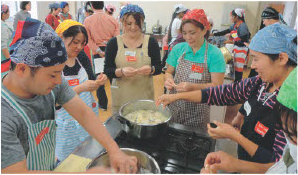

For individuals who are unable to gather
information due to physical disabilities, providing information
through alternative means is necessary. That opens information
accessibility. Gunma University has been pioneering various forms
of support for students with hearing impairments. Professor
Takayuki Kanazawa has initiated a collaborative project with Gunma
Prefecture this academic year, supported by the Nippon Foundation,
titled "Training Interpreters to Accommodate Academic Sign
Language Interpretation." He is enthusiastic about constructing a
curriculum for interpreter training and presenting this model
nationwide.
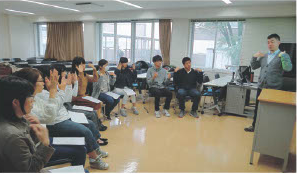
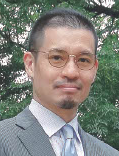
Professor Jun Iwai specializes in Social Information Systems, particularly focusing on decision support systems. His research involves anonymous communication, social choice theory, and approaches based on stress theory. He has pioneered the development of a "Combination-based Anonymity Scale" to measure levels of anonymity. In recent years, he has proposed privacy-conscious social survey techniques and advocated for improving the quality of big data.
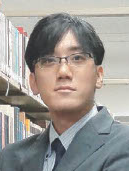
Associate Professor Akifumi Kira is engaged in research using mathematical and computational tools such as mathematical optimization and game theory to design fair and acceptable systems and policies for addressing social issues. He has collaborated with various fields to develop technological solutions, including; (a) Improving passenger satisfaction at Fukuoka Airport, (b) Coordinating the usage of the daycare facilities with an emphasis on siblinghood, (c) Developing security plans for cities and facilities, (d) Providing support for migration and settlement in Itoshima City, Fukuoka Prefecture, (e) Designing operational models for ride-sharing transportation.
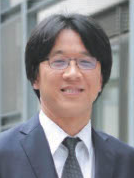
Professor Asakawa is researching intelligent artificial machines (sensors, signal processing devices, etc.) that mimic the information processing mechanisms of living organisms through a materials science approach. After obtaining his doctorate in 1996, he conducted research and development on the methodology of examining the solid structure and molecular motion of polymers. He was fascinated by the unique properties of polymers and one of their fundamental aspects, molecular motion. Around 2006, he considered whether this molecular motion could be applied to electronics. At that time, organic electronics devices were gaining attention, but their performance was significantly lower than silicon and compound semiconductors. He came to believe that for organic electronic devices to survive, it is necessary to pioneer new areas and harness the inherent characteristics of polymers. That's the direction of utilizing the features of polymers as they are, prompting him to focus his attention on the human brain.

Systemic sclerosis is a disease characterized by skin and internal organ hardening, vascular disorders, and immune abnormalities. It is a systemic condition with an unknown mechanism of onset. Patients often suffer from symptoms such as Raynaud's phenomenon and finger ulcers. A few years ago, we came across reports of symptom improvement through local injection of type A botulinum toxin in Europe and the United States. In collaboration with our Clinical Trials Department, we initiated a clinical study to develop the practical application (expansion of indications) of botulinum toxin injection therapy for Raynaud's phenomenon in systemic sclerosis. We conducted the world's first randomized blind trial of this therapy, which demonstrated improvement in the severity of Raynaud's symptoms and pain and reduction and healing of ulcers. We are currently in the process of the patent application. With valuable advice and guidance from the Pharmaceuticals and Medical Devices Agency (PMDA), we initiated our hospital's first physician-led clinical trial, starting in 2016.
In the basic research, we use cultured fibroblasts and systemic sclerosis mouse models to advance the understanding of skin fibrosis and peripheral vascular disorders' onset mechanisms, obtaining new insights. These achievements led us to receive the prestigious 2017 Japanese Society for Investigative Dermatology Award (JSID Award).

Associate Professor Sano is involved in forensic autopsy work as a physician and researches ABO blood type. Forensic medicine is a discipline that deals with legal issues based on medicine and natural sciences and provides expert opinions on them. ABO blood type is inherited, and in 1990, a Japanese research group elucidated the structure of the ABO gene in the Japanese population. For approximately 10 years, she has been researching the "gene expression mechanism" of how the ABO gene is regulated and contributes to the production of ABO blood-type substances. One of her focuses is studying the Bm type, which accounts for approximately half of the subtypes and variants in the Japanese population. In individuals with the Bm type, although the genetic structure is B type and the saliva is also B type, they are classified as O type in blood cell tests. Her research found that only the region responsible for activating gene expression in red blood cells was genetically missing in the Bm type.
On the other hand, the region involved in gene expression in epithelial cells remained intact, leading to the understanding of this phenomenon. In transplant medicine, incompatible blood types can cause rejection reactions. In addition, diseases associated with ABO blood types, such as the severity of thrombosis, have been identified. These findings indicate that A/B type substances can pose risks in transplantation medicine and disease development. She believes that by utilizing their research, it will be possible to develop methods to decrease the levels of blood-type substances. Furthermore, the association between ABO blood type and susceptibility to cancer has been reported worldwide, and she aims to elucidate the mechanism behind it from their perspective.

Assistant Professor Yuya Tachibana has been actively working on the development of new materials and plastics using furfural derived from biomass resources. In 2013, he served as a PRESTO researcher under the Japan Science and Technology Agency (JST). Since 2016, he has received support from the JST's Advanced Low Carbon Technology Research and Development (ALCA) project, focusing on developing plastics from furfural produced from food waste. One of his achievements includes synthesizing terephthalic acid, one of the raw materials for polyethylene terephthalate (PET) resin, from furfural. He has also succeeded in creating biodegradable plastics from furfural that can be decomposed by microorganisms in the natural environment without causing environmental pollution.
The Tokyo Olympic and Paralympic Games will be held from July 24 to August 9, 2020, and from August 25 to September 6, 2020. During this period, an increase in sweltering days is expected, making heatstroke prevention a crucial issue. Professor Kenji Amagai from the Graduate School of Science and Technology has been researching and developing with the Tokyo Metropolitan Agriculture and Forestry Research Center to create cool outdoor spaces using portable greening technology, even on scorching hot days. The research and development started with a demonstration experiment conducted in Tatebayashi City, Gunma Prefecture, known for its high summer temperatures, where an artificial forest was created in 2012, incorporating the effects of mist to create a cool environment. The research results caught the attention of officials from the Tokyo Metropolitan Government, leading to the development of portable greening benches for the year 2020. In addition to the collaboration between our university and the Tokyo Metropolitan Agriculture and Forestry Research Center, multiple companies, including forestry cooperatives, landscaping associations, and mist nozzle manufacturers, have participated in this industry-government-academia collaboration.
From 2014 to 2016, he conducted demonstration experiments at Tokyo Big Sight. The results showed that while the atmospheric temperature could only be reduced by approximately 1°C even with the evaporative effect of mist, the black globe temperature (close to apparent temperature) could be reduced by more than 10°C, proving its effectiveness as a measure against heatstroke. Furthermore, development efforts were made to provide a cool environment for individuals using wheelchairs in preparation for the Paralympic Games. Therefore, this technology is expected to be utilized as an urban summer heat countermeasure even after the Olympic and Paralympic Games.

Professor Amagai and people who cooperated in the evaluation
process
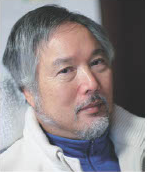
After graduating from the Faculty of Education at Gunma University, Tomohiro Hoshino became a junior high school teacher. However, during his club activities, he suffered a cervical spine injury that resulted in losing limb mobility. While hospitalized and recovering at Gunma University Hospital, he began writing poems and creating art by holding a brush in his mouth, inspired by advice from nursing students. Subsequently, his poetry and artworks were serialized in magazines and newspapers, and he had nationwide "Flower Poetry and Art Exhibitions" that moved many people. He also held such exhibitions in New York, Honolulu, Los Angeles, and Warsaw. In 1991, the Tomihiro Art Museum was established in his hometown, and 2005, the New Tomihiro Art Museum was opened, attracting over 6.5 million visitors by 2014, evoking great inspiration.
In 2006, he was honored as an Honorary Citizen of Gunma Prefecture, and in 2011, he received the Gunma University Special Honor Award, becoming the first recipient of this prestigious award. The award aims to recognize individuals, whether students or faculty members, who have made significant achievements in academic, cultural, and social contributions, bringing pride to the university.
In 2012, Tomihiro Hoshino donated 45 pieces of his poetry and art to Gunma University. Furthermore, at the affiliated hospital of the medical school, a "Tomihiro Hoshino Flower Poetry and Art Corner" was established, where seasonal works are exhibited. That improves the healing environment and fosters individuals with enriched sensitivity among patients, visitors, general citizens, students, and faculty members. Additionally, the hallways are adorned with printed reproductions of artworks created by Tomihiro Hoshino during his recovery, creating a cozy atmosphere.

Tomihiro Hoshino Flower Poetry and Art Corner
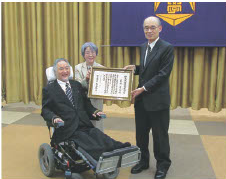
Award ceremony of Gunma University Special Honor Award